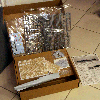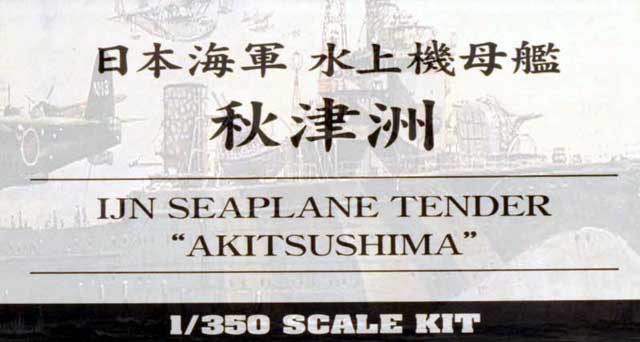| The Kit |
|
|
Hasegawa produced the Akitsushima in 1/350 as a limited edition multi-media kit. Released in February 2009, it was available only in the Japanese market by ordering it directly from the manufacturer. Three ModelWarship Forum members were fortunate enough to acquire examples of this kit through the kindness of fellow member Gernot Hassenpflug, who, being a resident of Tokyo, was able to get hold of the kits and ship them to us.
The kit arrived in a plain brown cardboard box. The parts inside were packed impeccably and arrived without damage. My first impressions were that the box was lighter than I expected and, after opening, that the ship was smaller than I thought! Not much longer than a Akitsuki destroyer, although, naturally, more than twice as wide.
The box contained:
- A solid resin hull (no waterline option)
- Two bags of resin parts, one for the larger superstructure parts and one for smaller details
- Two bags of grey injection-moulded sprues
- A bag with a clear injection-moulded sprue and a decal sheet
- Four PE frets
- A small bag of solid brass parts
- A small bag of white metal parts
- A length of chain
- A brass rod
- An instruction booklet
|
|
|
|
|
| HULL |
|
|
The resin casting is excellent, with no pinholes anywhere, and only a small gate to be removed from the rudder position. The hull plates are there, and in much finer form than in any of the new 1/350 IJN injection-moulded kits. No Nagato-style trenches here!
The portholes are fine, but shallow. They will benefit from being drilled a bit deeper. All other external hull fittings seem to be present.
The deck, as in most IJN warships, was a combination of anti-skid steel plates and linoleum. The anti-skid pattern is very fine, finer than the same company’s Yukikaze, and the retaining strips for the linoleum are also very fine. All chocks and such are moulded cleanly. No “Aztec Steps” are provided! The areas where the superstructure will go are slightly inlaid, which should ease the fit.
|
|
 |
|
|
| RESIN PARTS |
|
|
The first bag contains the superstructure parts, gun shield, crane base, funnel and a pinnace. They are cleanly moulded, with minimal cleaning required. The gun shield and horizontal overhangs, where they exist, are commendably thin and nothing seems to be warped. The funnel is lovely, with the diesel exhausts very well cast. The portholes will require a little drilling to look their best.
The second bag contains the finer parts, including gun bases, derricks, propellers, propeller brackets, paravanes, anchors, ammunition and tool boxes, gun director, aircraft spare parts, rudder, and several more pieces I have yet to identify. The parts are eitheron wafer-thin sheets of resin or on resin sprues and will require cleaning. Still, everything looks perfectly cast and should pose no problems in the build.
|
|
|
| PLASTIC PARTS |
|
|
The first bag has two identical sprues inside, and it provides boats, derricks, anchors, etc,
These sprues have already been seen on Nagato and also released by Hasegawa as “Japanese Navy Warships Boats Set A” (Code QG 19)
The second bag also has two identical sprues inside, and it provides the standard lighter weapons of the IJN, from 5 inch A/A down to triple, double and single 25mm A/A as well as directors, cable reels, mushroom vents and other small details. These were also part of the Nagato sprues and were released later as “Japanese Navy Ship Equipment
Set A (Machine Guns and Optical Weapons)” (Code QG 18)
The third bag contains one clear sprue, with an Emily flying boat and a decal sheet of aircraft markings as well as flags for the ship. An identical sprue was contained, as a bonus, in the initial release of the Hasegawa Yukikaze 1940 as a bonus. I do not know whether it is present in later boxings.
|
|
|
| PHOTOETCH |
|
|
Four frets in total, of which two are identical. They look good, but, as all Japanese PE, are nowhere near as fine as the best aftermarket PE (WEM and GMM)
“Fret A” contains gun bases, degaussing cable, railings, funnel details, stairs, boat derricks and cradles, small lattice masts, and various structural details.
“Fret B” is half the size of the others. It contains more boat cradles, more structural parts, the crane, radar, another small lattice mast, boat booms with ladders, more railings, spars, and other small details.
Two more identical generic frets are provided. Hasegawa calls the “1/350 Japanese Navy General Etching Parts A”. They include porthole covers, ladder stock, reels, doors, life rings, boat cradles, stairs, the Imperial Chrysanthemum in 3 sizes, pulleys, brass strips for linoleum, aircraft rails, boat details and some other, not immediately identifiable, small parts.
|
|
| MISC PARTS |
|
|
You may laugh, but I fell in love with the contents of this small bag: six perfectly formed jewel-like brass depth charges! Why, oh why, couldn’t they provide a hundred more? I’ve used them in plastic, in resin and in white metal, but none were as nice as these! An aftermarket opportunity perhaps? So many destroyers – and more to come…
A length of fine chain is also provided for the anchor, as well as a brass rod. I don’t think you require my comments on these!.
|
|
|
| INSTRUCTIONS |
|
|
They come in the usual Hasegawa booklet form, 16 pages long and very comprehensive.
Interestingly, it’s not only in Japanese, but some basic instructions are in English. As usual, colours from the Mr Color and Aqueous Hobby Color ranges by GSI Creos (ex-Gunze Sangyo) are referenced.
|
|
|
| CONCLUSIONS |
|
|
I have mixed feelings about this kit. Positive points: a unique subject, eminently buildable. Negative points: What’s all this with previously released injection sprues and generic PE at this price level?
All in all, you have to REALLY like the IJN to get this kit – or be a kit collector…
A final thought. In the Japanese magazine “Navy Yard” vol.10, two built Akitsushimas are featured. One is the 1942 seaplane tender version which this kit represents and the other is the 1944 transport version (with 5 lovely little PT boats on deck). My kit has no parts for the 1944 version. Does another limited edition already exist or is something due in the near future? The world wants to know!
|

